Analysis of Influence of Grid-Following and Grid-Forming Static Var Generators on High-Frequency Resonance in Doubly Fed Induction Generator-Based Wind Farms
Abstract
1. Introduction
- Based on harmonic linearization theory, a high-frequency sequence impedance model is established for a DFIG-based wind farm with SVG, taking into account the power factor control outer loop. Based on the theoretical impedance model, the variation law of high-frequency impedance in the DFIG-based wind farm with GFL SVG is analyzed to reveal the occurrence mechanism of high-frequency resonance after an unloaded cable is put into operation.
- Without additional investment, the wind farm’s self-equipped GFL SVG is transformed into GFM control, and a high-frequency sequence impedance model for GFM SVG is established. For GFM and GFL SVG, a comparative analysis is conducted on the impedance characteristics to investigate GFM SVG’s impact on the high-frequency impedance characteristics of the wind farm. The proposed method presents a novel perspective for suppressing high-frequency resonance in the wind farm system.
2. Structure of DFIG-Based Wind Farm and Resonance Issues
3. Modeling of Sequence Impedance for DFIG
3.1. RSC Sequence Impedance
3.2. GSC Sequence Impedance
3.3. Verification of Impedance Model
4. Modeling of Sequence Impedance for SVG of Two Control Types
4.1. Sequence Impedance of GFL SVG
4.2. Sequence Impedance of GFM SVG
4.3. Verification of Impedance Model
5. Analysis of the Influence of GFL SVG on High-Frequency Resonance in Wind Farm
5.1. Analysis of High-Frequency Resonance Mechanism in Wind Farm
5.2. The Influence of Voltage Feedforward in GFL SVG on System Stability
6. The Suppression Effect of GFM SVG on High-Frequency Resonance in Wind Farm
6.1. Resonance Suppression Mechanism of GFM SVG for Wind Farm
6.2. Influence of SVG Control Parameters on the System Stability
7. Experimental Verification
7.1. GFL SVG
7.2. GFM SVG
8. Conclusions
- The voltage feedforward loop of GFL SVG directly affects the impedance characteristics of the wind farm system. With an increase in the feedforward coefficient, the impedance of the system changes from positive damping characteristics to negative damping characteristics in the high-frequency band, increasing the resonant risk of the system.
- When the GFL SVG adopts a fixed power factor control mode, under the dual effects of cable-to-ground capacitance and capacitive impedance of the GFL SVG in the high-frequency band, the unloaded cable in the wind farm will further reduce the high-frequency impedance phase margin of the system, resulting in the lack of phase margin of the system, which ultimately triggering high-frequency resonance.
- Due to the omission of voltage feedforward in GFM SVG, it is evaded that resonance signal injection into the control system caused by voltage feedforward, so that the overall impedance of the system shows positive damping characteristics in the high-frequency band, and the resonance of the wind farm is suppressed. At the same time, within a reasonable band, changes in parameters in the power synchronization loop in the GFM only affect dynamic reactive power compensation of the SVG and do not affect its suppression of high-frequency resonance in the wind farm.
Author Contributions
Funding
Data Availability Statement
Conflicts of Interest
Appendix A
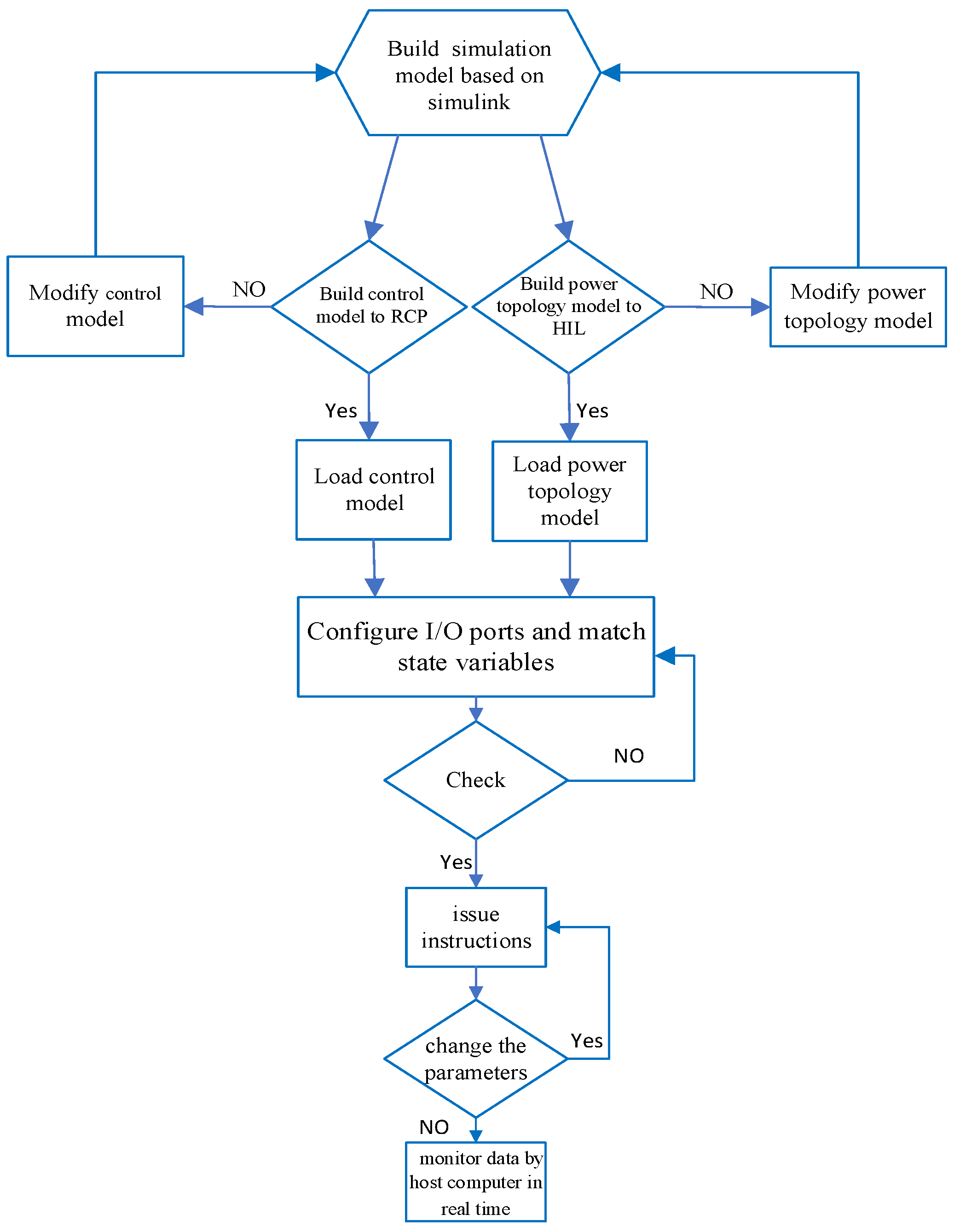

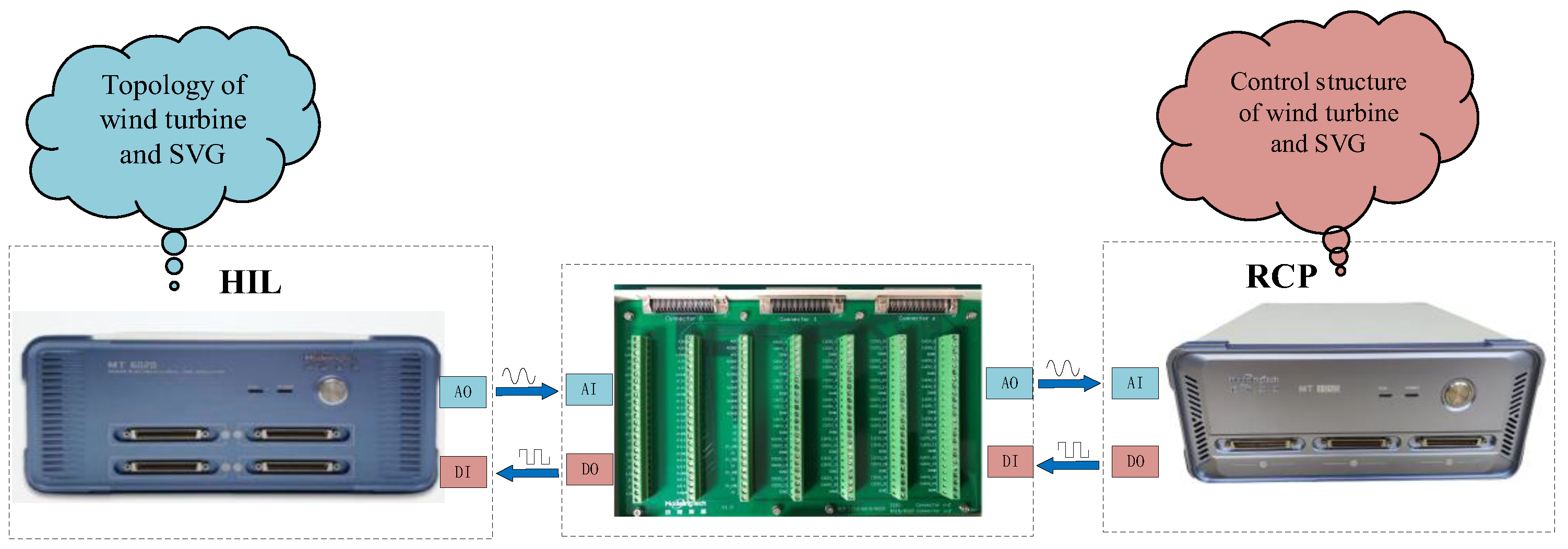
References
- Liu, Y.; Zheng, J.; Chen, Q.; Duan, Z.; Tian, Y.; Ban, M.; Li, Z. MMC-STATCOM supplementary wide-band damping control to mitigate subsynchronous control interaction in wind farms. Int. J. Electr. Power Energy Syst. 2022, 141, 108171. [Google Scholar] [CrossRef]
- Ma, J.; Yang, Z.; Du, W.; Shen, Y.; Cheng, P. An active damping control method for direct-drive wind farm with flexible DC transmission system based on the remodeling of dynamic energy branches. Int. J. Electr. Power Energy Syst. 2022, 141, 108004. [Google Scholar] [CrossRef]
- Chi, Y.; Tang, B.; Hu, J.; Tian, X.; Tang, H.; Li, Y.; Sun, S.; Shi, L.; Shuai, L. Overview of mechanism and mitigation measures on multi-frequency oscillation caused by large-scale integration of wind power. CSEE J. Power Energy Syst. 2019, 5, 433–443. [Google Scholar]
- Liu, C.; Han, J.; Shang, L. Review of modeling and evaluation of wide-band oscillation in power systems integrated with renewable energy generation in view of energy. Power Syst. Technol. 2023, 47, 3980–3993. [Google Scholar]
- Cheah-Mane, M.; Sainz, L.; Liang, J.; Jenkins, N.; Ugalde-Loo, C.E. Criterion for the electrical resonance stability of offshore wind power plants connected through HVDC links. IEEE Trans. Power Syst. 2017, 32, 4579–4589. [Google Scholar] [CrossRef]
- Gan, F.; Guo, C.; Chen, H. Analysis and evaluation of the applicability of doubly-fed wind farm equivalent impedance model in high frequency resonance research. Proc. CSEE 2023, 43, 7497–7509. [Google Scholar]
- Song, Y.; Wang, X.; Blaabjerg, F. Impedance-based high-frequency resonance analysis of DFIG system in weak grids. IEEE Trans. Power Electron. 2016, 32, 3536–3548. [Google Scholar] [CrossRef]
- Song, Y.; Ebrahimzadeh, E.; Blaabjerg, F. Analysis of high-frequency resonance in DFIG-based offshore wind farm via long transmission cable. IEEE Trans. Energy Convers. 2018, 33, 1036–1046. [Google Scholar] [CrossRef]
- Song, Y.; Blaabjerg, F.; Wang, X. Analysis and active damping of multiple high frequency resonances in DFIG system. IEEE Trans. Energy Convers. 2016, 32, 369–381. [Google Scholar] [CrossRef]
- Wang, X.; Liu, H.; Hu, X.; Wu, L.; Lan, H.; Sheng, S.; Niu, L. Impacting factors and stability analysis of resonance in multiple wind farms integration through VSC-HVDC system. In Proceedings of the 2018 International Conference on Power System Technology (POWERCON), Guangzhou, China, 6–8 November 2018; pp. 2177–2182. [Google Scholar]
- Sainz, L.; Monjo, L.; Pedra, J.; Cheah-Mane, M.; Liang, J.; Gomis-Bellmunt, O. Effect of wind turbine converter control on wind power plant harmonic response and resonances. IET Electr. Power Appl. 2017, 11, 157–168. [Google Scholar] [CrossRef]
- Zhang, Y.; Wang, Y.; Zhang, D.; Chen, X.; Gong, C. Broadband impedance shaping control scheme of MMC-based STATCOM for improving the stability of the wind farm. IEEE Trans. Power Electron. 2021, 36, 10278–10292. [Google Scholar] [CrossRef]
- Hu, B.; Nian, H.; Yang, J.; Li, M.; Xu, Y. High-frequency resonance analysis and reshaping control strategy of DFIG system based on DPC. IEEE Trans. Power Electron. 2020, 36, 7810–7819. [Google Scholar] [CrossRef]
- Pang, B.; Nian, H.; Xu, Y. Mechanism analysis and damping method for high frequency resonance between VSC-HVDC and the wind farm. IEEE Trans. Energy Convers. 2020, 36, 984–994. [Google Scholar] [CrossRef]
- Wang, J.; Chen, W.; Liu, Y.; Fu, C.; Ye, Y.; Feng, J. High frequency resonance analysis and impedance reshaping control of MMC-HVDC system based on frequency coupling impedance model. J. Mod. Power Syst. Clean Energy 2023, 12, 646–657. [Google Scholar] [CrossRef]
- Feng, J.; Zou, C.; Yang, S.; Zhao, X.; Fu, C.; Li, Y.; Xu, S.K. Accurate impedance modeling and characteristic analysis of VSC-HVDC system for mid-and high-frequency resonance problems. Proc. CSEE 2020, 40, 4805–4820. [Google Scholar]
- Wang, X.; Li, Y.W.; Blaabjerg, F.; Loh, P.C. Virtual-impedance-based control for voltage-source and current-source converters. IEEE Trans. Power Electron. 2014, 30, 7019–7037. [Google Scholar] [CrossRef]
- Li, C.; Chen, D.; Wei, J.; Wu, Q.; Yu, H.; Zhang, X.; Ren, W. Parallel impedance-reshaping control strategy for suppressing wide range high-frequency resonance of shunt compensated DFIG system. IEEE Trans. Ind. Appl. 2023, 59, 5672–5681. [Google Scholar] [CrossRef]
- Zhang, H.; Zhang, W.; Lin, W.; Wen, J. Grid forming converters in renewable energy sources dominated power grid: Control strategy, stability, application, and challenges. J. Mod. Power Syst. Clean Energy 2021, 9, 1239–1256. [Google Scholar] [CrossRef]
- Babu, V.V.; Roselyn, J.P.; Nithya, C.; Sundaravadivel, P. Development of Grid-Forming and Grid-Following Inverter Control in Microgrid Network Ensuring Grid Stability and Frequency Response. Electronics 2024, 13, 1958. [Google Scholar] [CrossRef]
- Harnefors, L.; Rahman, F.M.; Hinkkanen, M.; Routimo, M. Reference-feedforward power-synchronization control. IEEE Trans. Power Electron. 2020, 35, 8878–8881. [Google Scholar] [CrossRef]
- Wu, W.; Zhou, L.; Chen, Y.; Luo, A.; Dong, Y.; Zhou, X.; Xu, Q.; Yang, L.; Guerrero, J.M. Sequence-impedance-based stability comparison between VSGs and traditional grid-connected inverters. IEEE Trans. Power Electron. 2018, 34, 46–52. [Google Scholar] [CrossRef]
- Xu, Y.; Nian, H.; Kang, J.; Zhao, J.; Wang, Z.; Zhou, J. Impedance-based analysis of potential stability risk between grid-forming and grid-following wind turbine systems. In Proceedings of the 2021 6th Asia Conference on Power and Electrical Engineering (ACPEE), Chongqing, China, 8–11 April 2021; pp. 858–862. [Google Scholar]
- Yan, W.; Shah, S.; Gevorgian, V.; Koralewicz, P.; Wallen, R.; Gao, D.W. On the Low Risk of SSR in Type III Wind Turbines Operating with Grid-Forming Control. IEEE Trans. Sustain. Energy 2023, 74–79. [Google Scholar]
- Li, G.; Chen, Y.; Luo, A.; Wang, H. An enhancing grid stiffness control strategy of STATCOM/BESS for damping sub-synchronous resonance in wind farm connected to weak grid. IEEE Trans. Ind. Inform. 2019, 16, 5835–5845. [Google Scholar] [CrossRef]
- Xu, Y.; Nian, H.; Chen, L. Small-signal modeling and analysis of DC-link dynamics in type-IV wind turbine system. IEEE Trans. Ind. Electron. 2020, 68, 1423–1433. [Google Scholar] [CrossRef]
- Cespedes, M.; Sun, J. Impedance modeling and analysis of grid-connected voltage-source converters. IEEE Trans. Power Electron. 2013, 29, 1254–1261. [Google Scholar] [CrossRef]
- Tong, H.; Nian, H.; Hu, B.; Li, M.; Zhang, H.; Liu, Q. High-frequency resonance analysis between DFIG based wind farm with direct power control and VSC-HVDC. In Proceedings of the 2021 24th International Conference on Electrical Machines and Systems (ICEMS), Gyeongju, Republic of Korea, 31 October–3 November 2021; pp. 2207–2212. [Google Scholar]
- Jansen, K.; Van Hulst, B.; Engelbrecht, C.; Hesen, P.; Velitsikakis, K.; Lakenbrink, C. Resonances due to long HVAC offshore cable connections: Studies to verify the immunity of dutch transmission network. In Proceedings of the 2015 IEEE Eindhoven PowerTech, Eindhoven, The Netherlands, 29 June–2 July 2015; pp. 1–6. [Google Scholar]
- Zou, C.; Rao, H.; Xu, S.; Li, Y.; Li, W.; Chen, J.; Zhao, X.; Yang, Y.; Lei, B. Analysis of resonance between a VSC-HVDC converter and the AC grid. IEEE Trans. Power Electron. 2018, 33, 10157–10168. [Google Scholar] [CrossRef]
- Hou, Y.; Liu, C.; Wang, Y.; Kong, W. Mechanism analysis of additional daming control strategies for the high-frequency resonance of MMC connected to AC grid. CSEE J. Power Energy Syst. 2021, 9, 1173–1181. [Google Scholar]
- Rygg, A.; Molinas, M.; Zhang, C.; Cai, X. A modified sequence-domain impedance definition and its equivalence to the dq-domain impedance definition for the stability analysis of AC power electronic systems. IEEE J. Emerg. Sel. Top. Power Electron. 2016, 4, 1383–1396. [Google Scholar] [CrossRef]
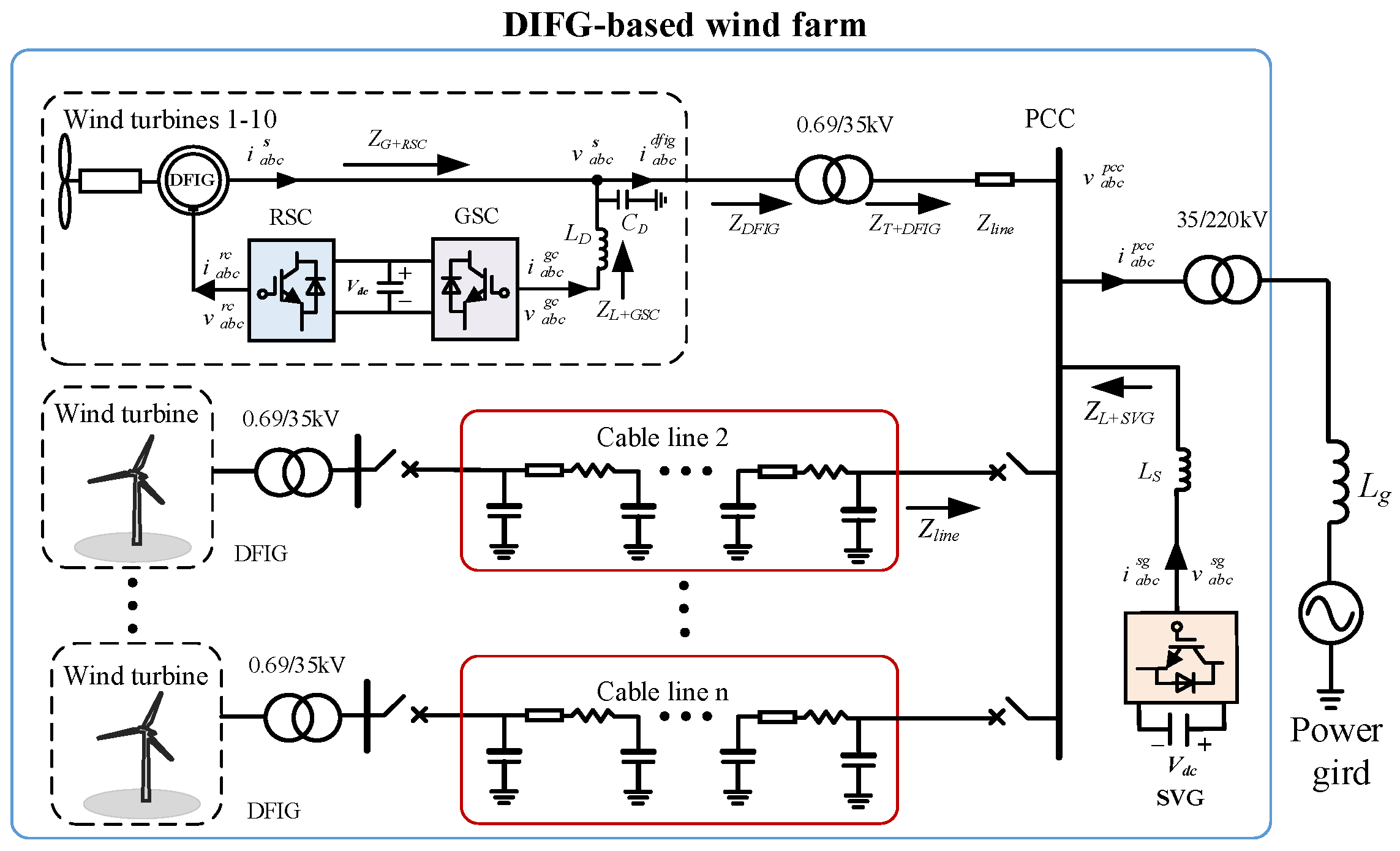

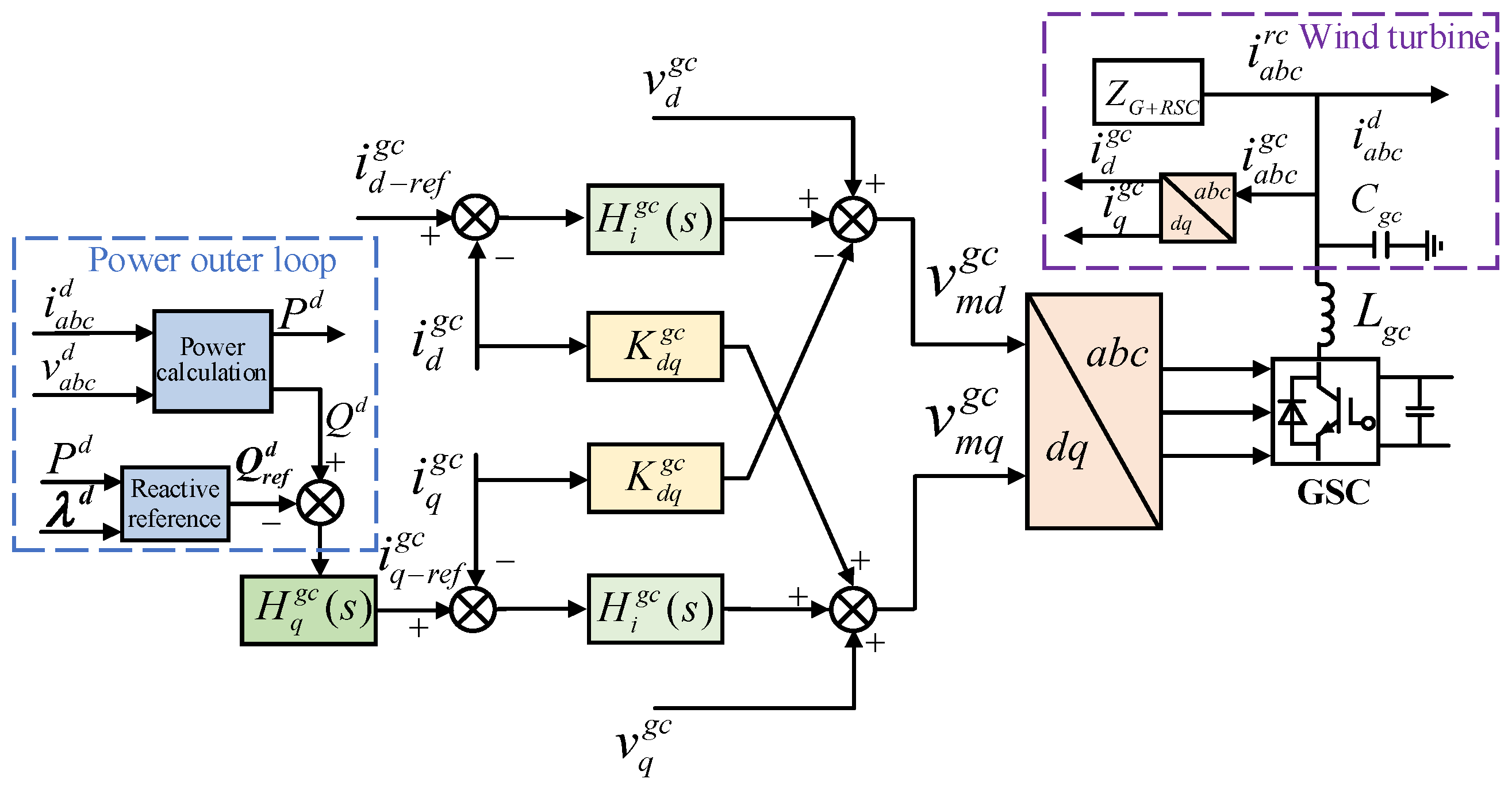

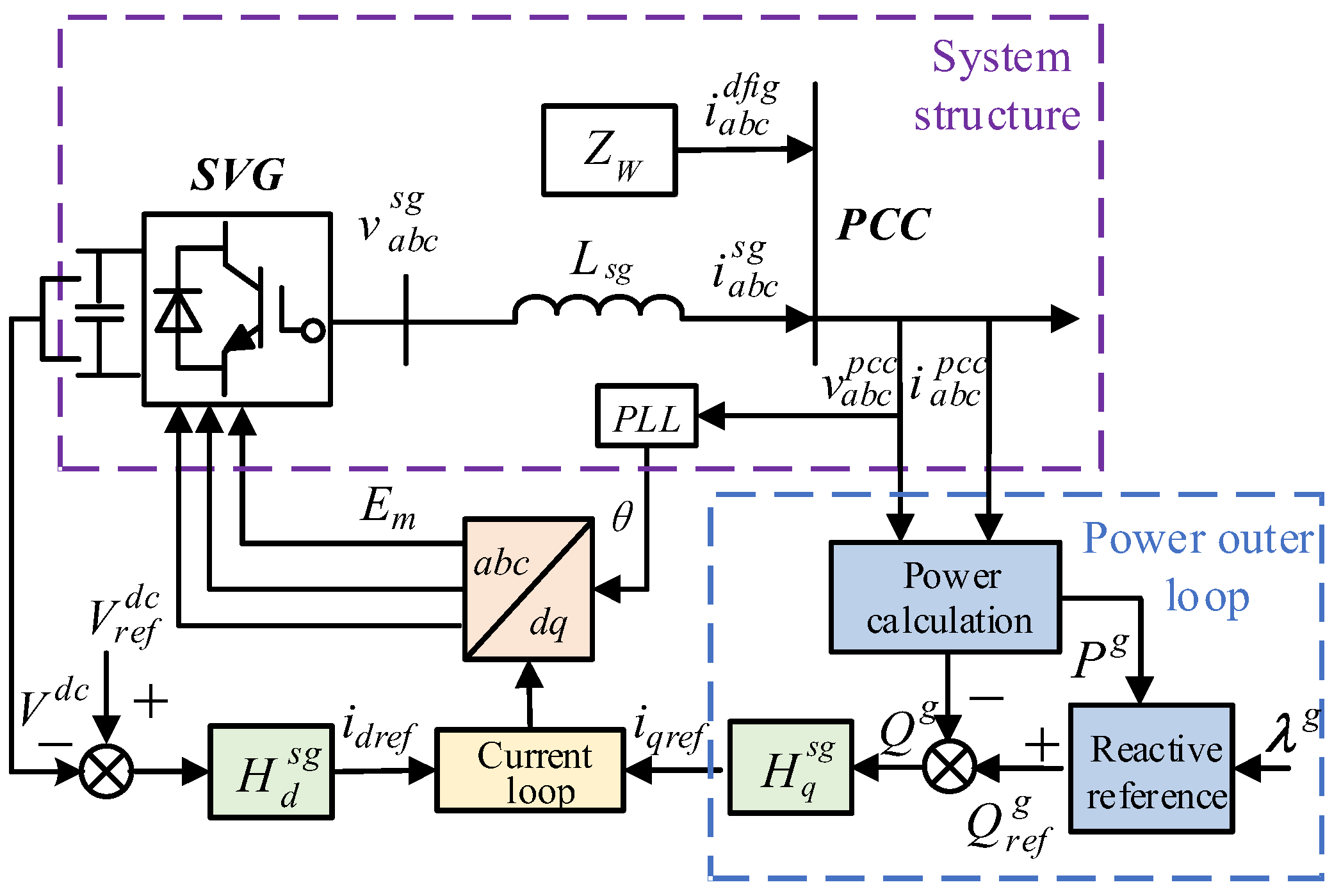
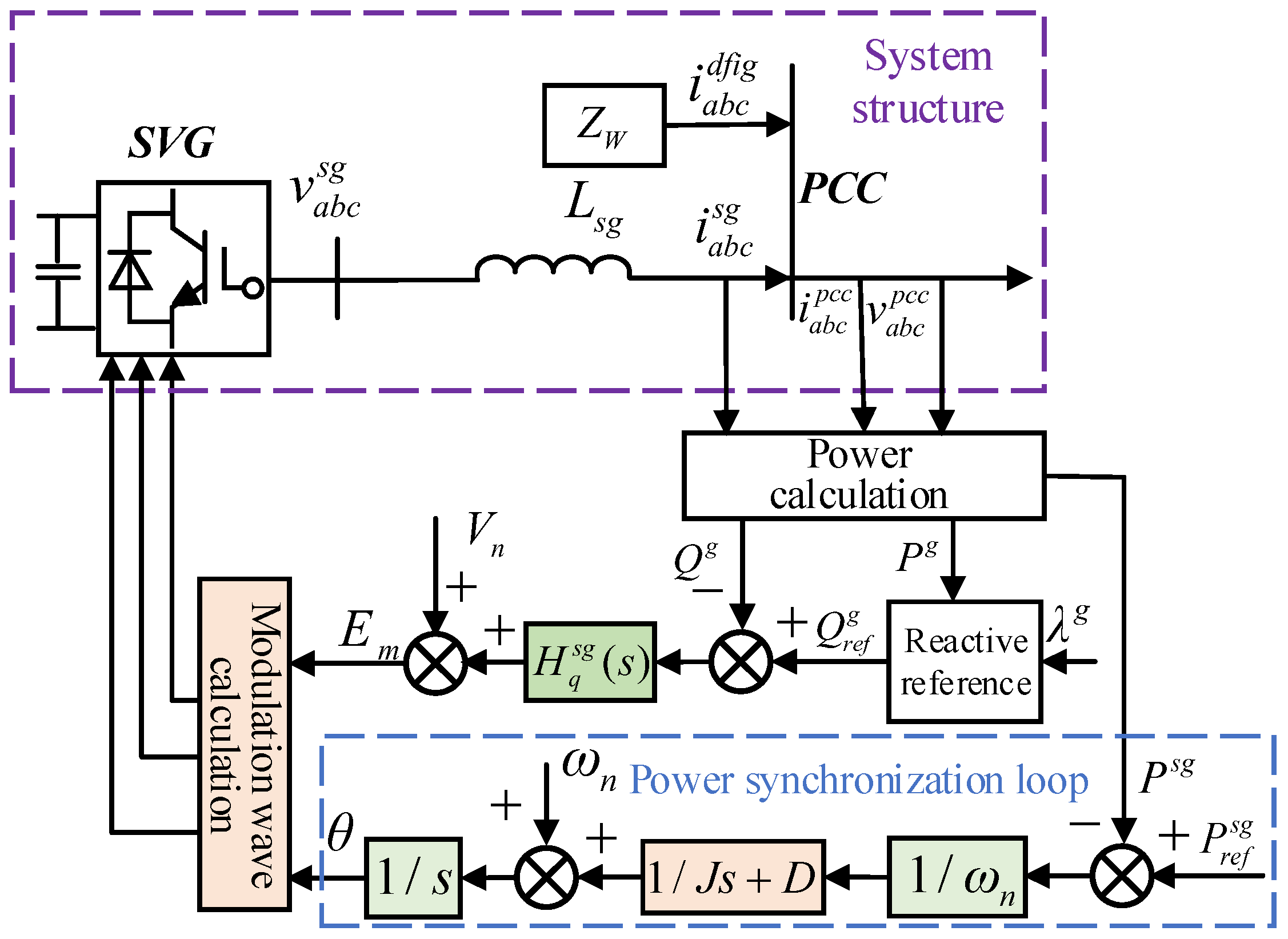
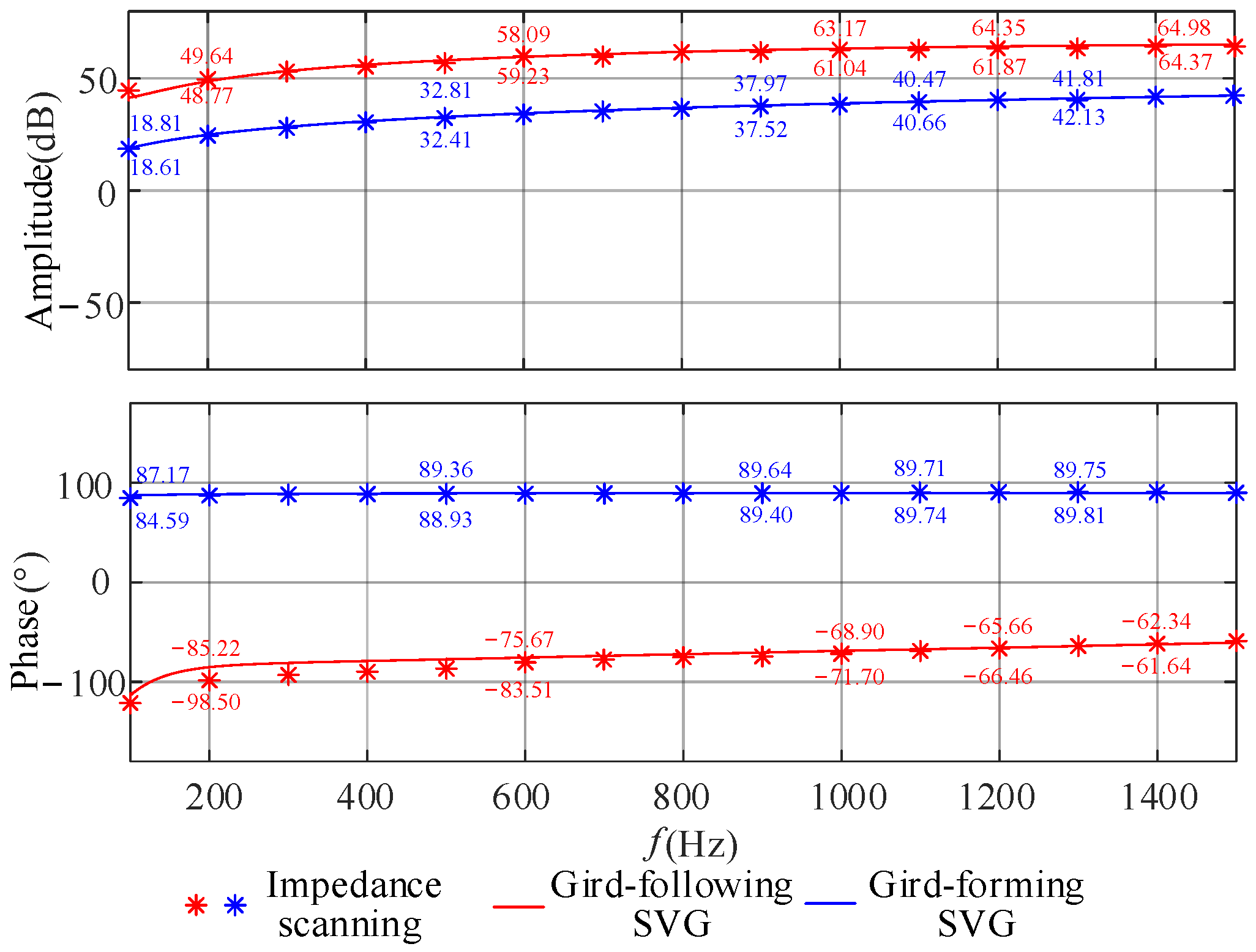


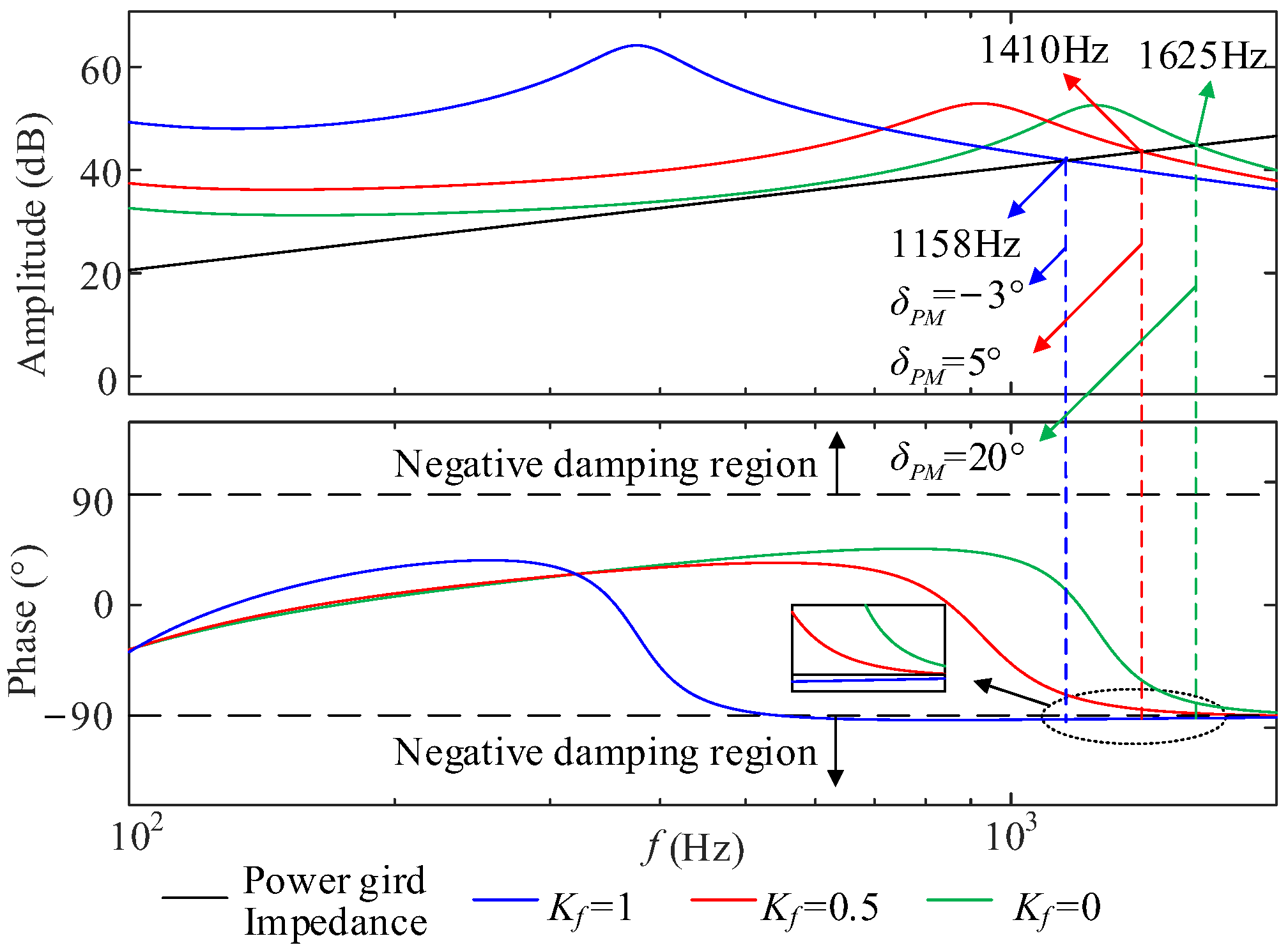

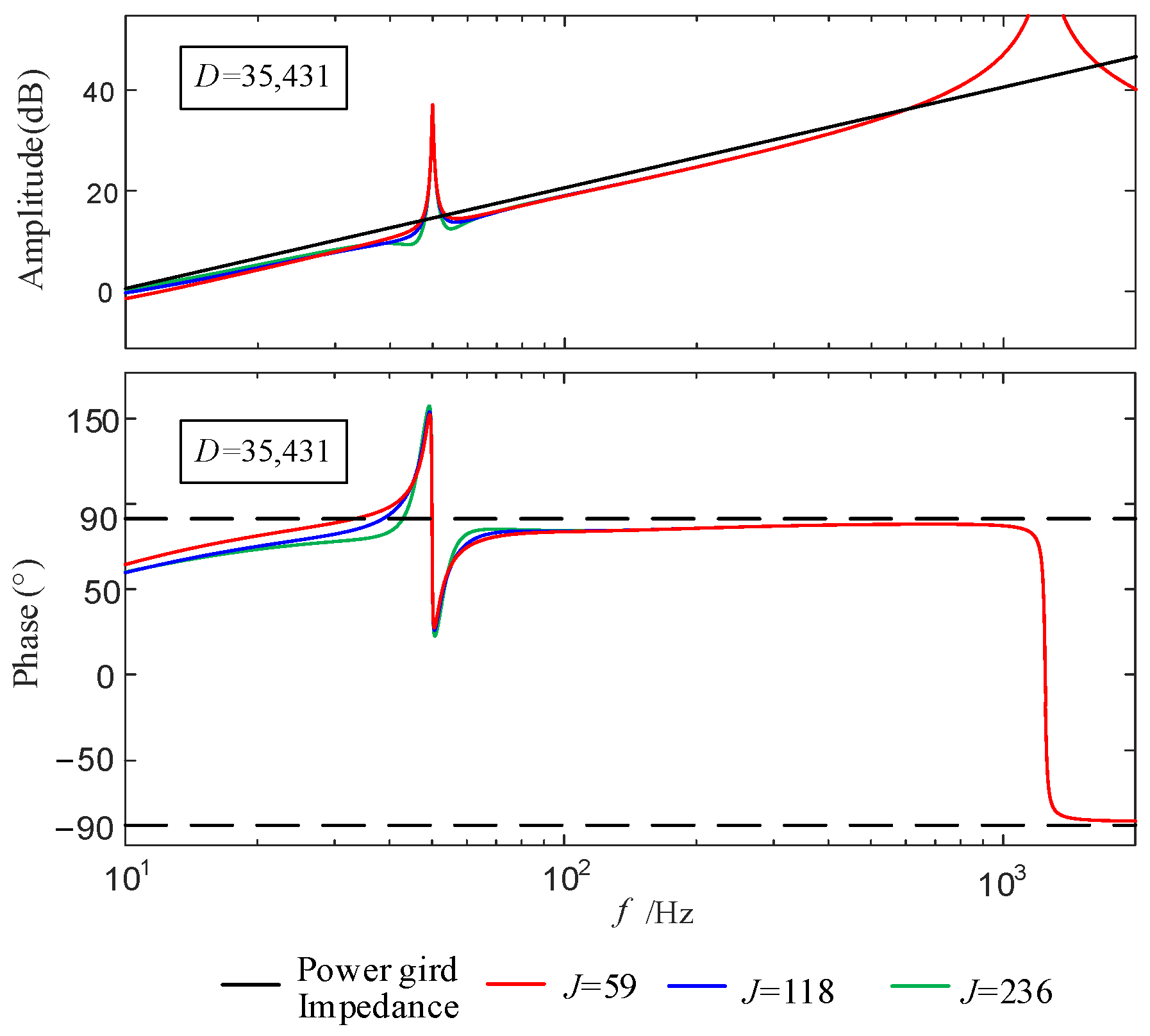
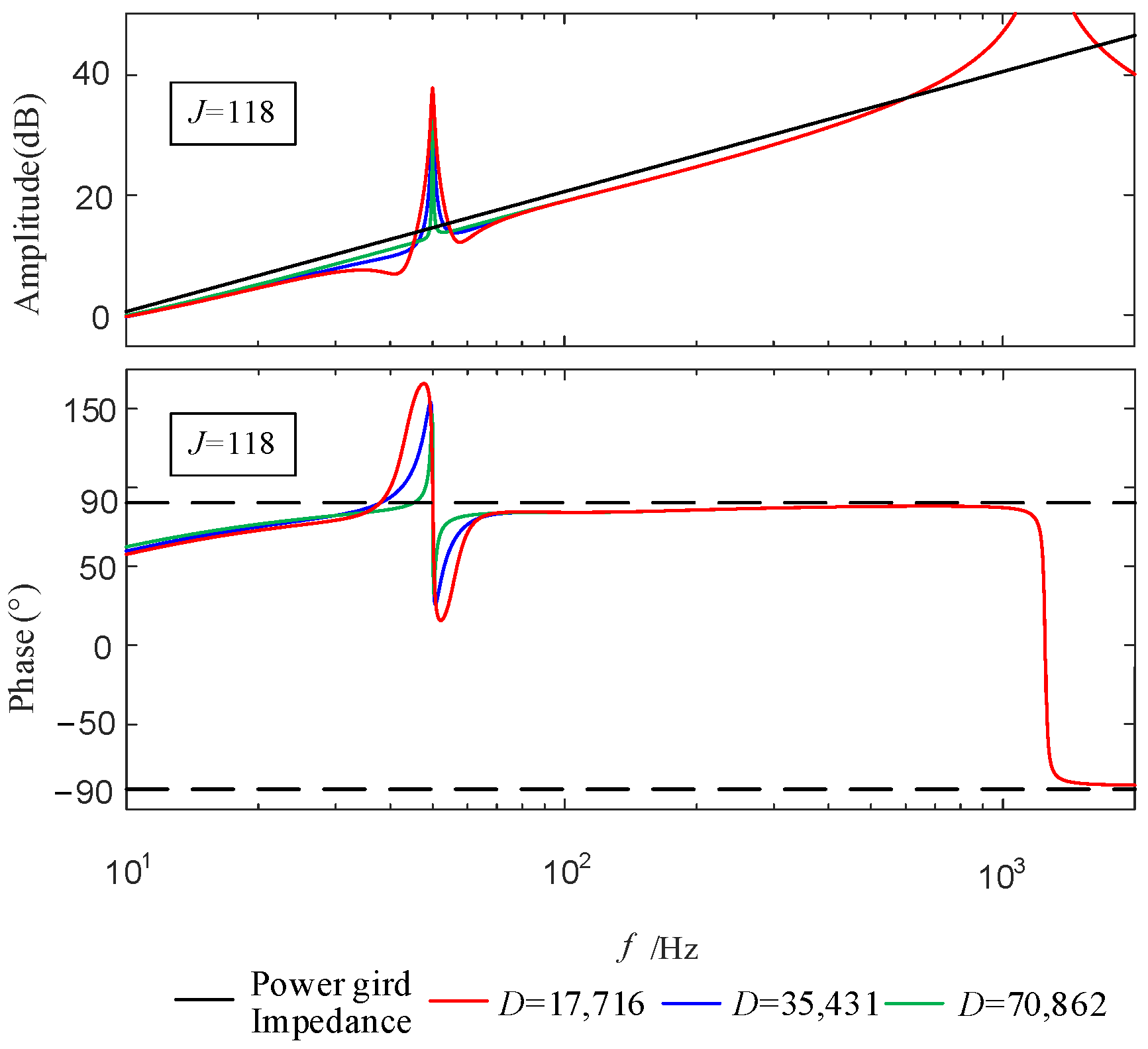

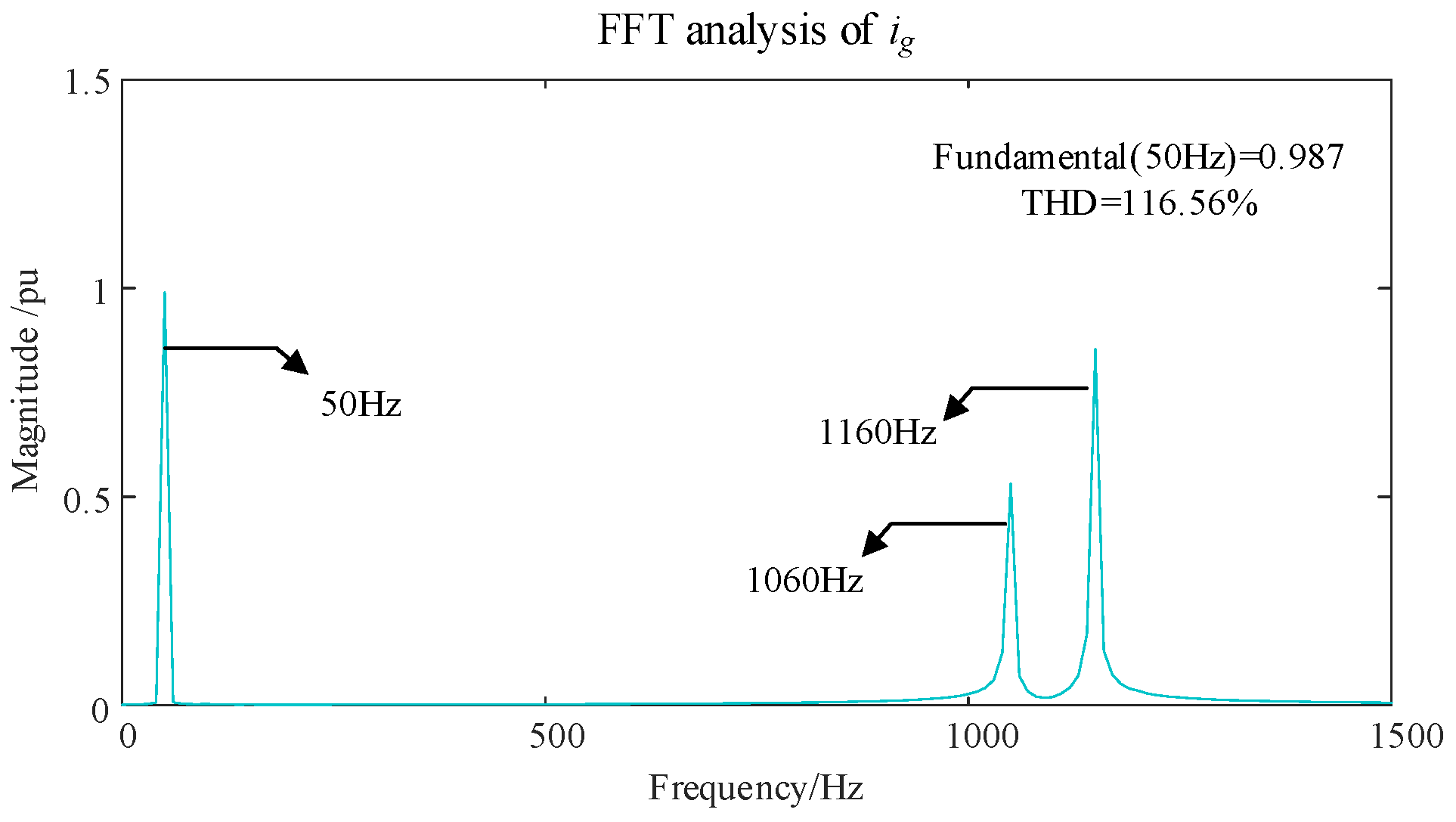

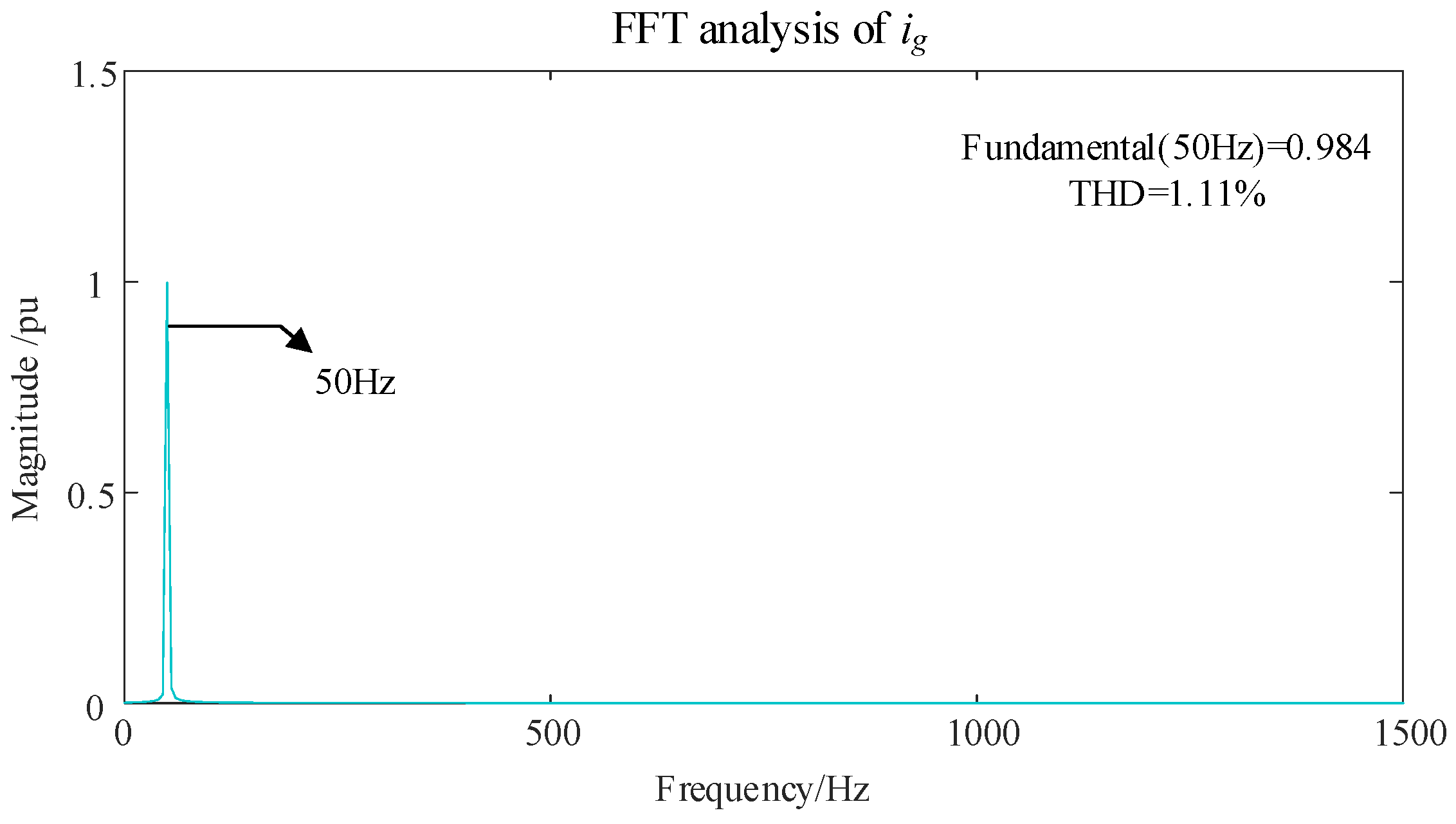
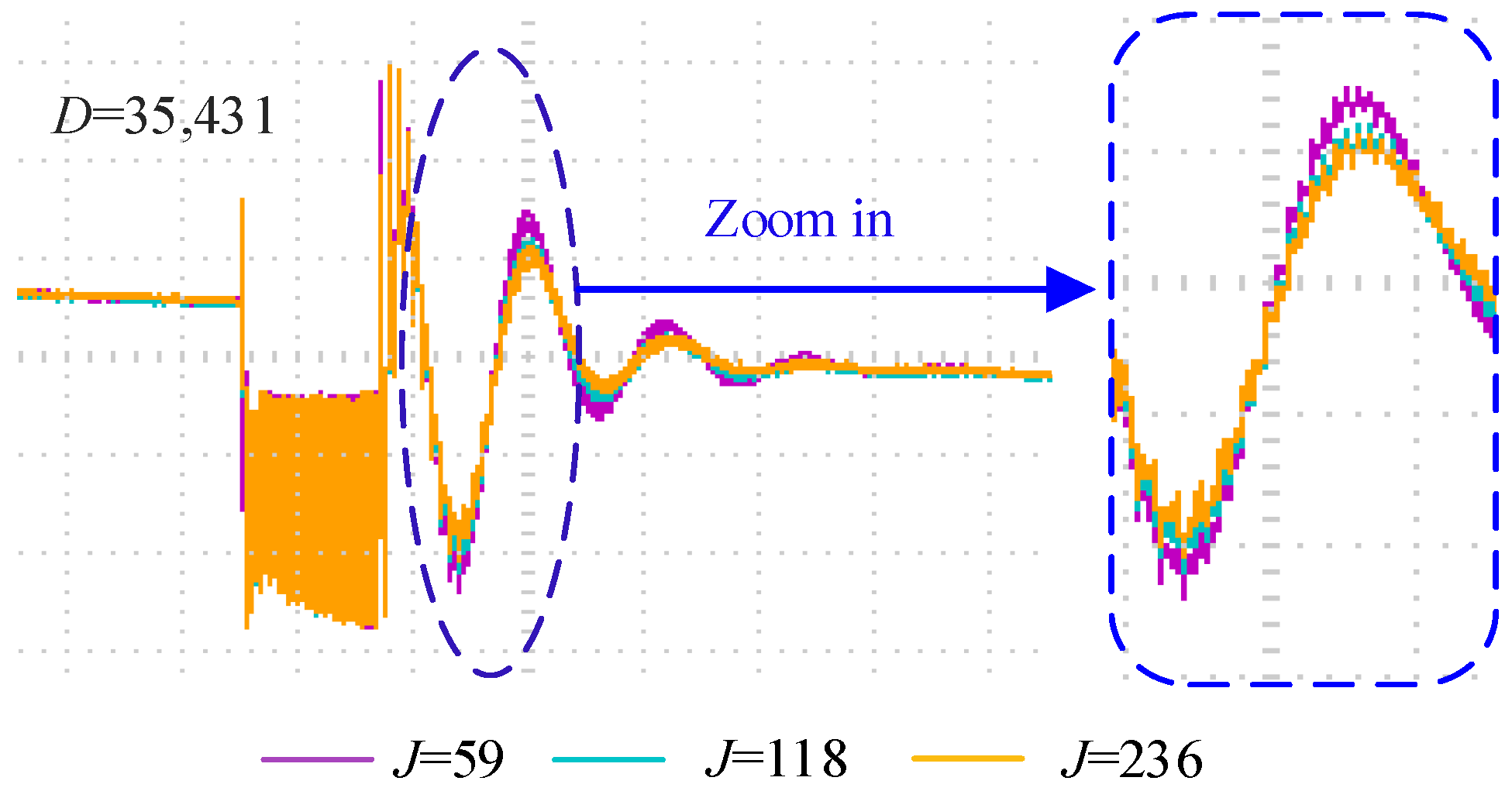
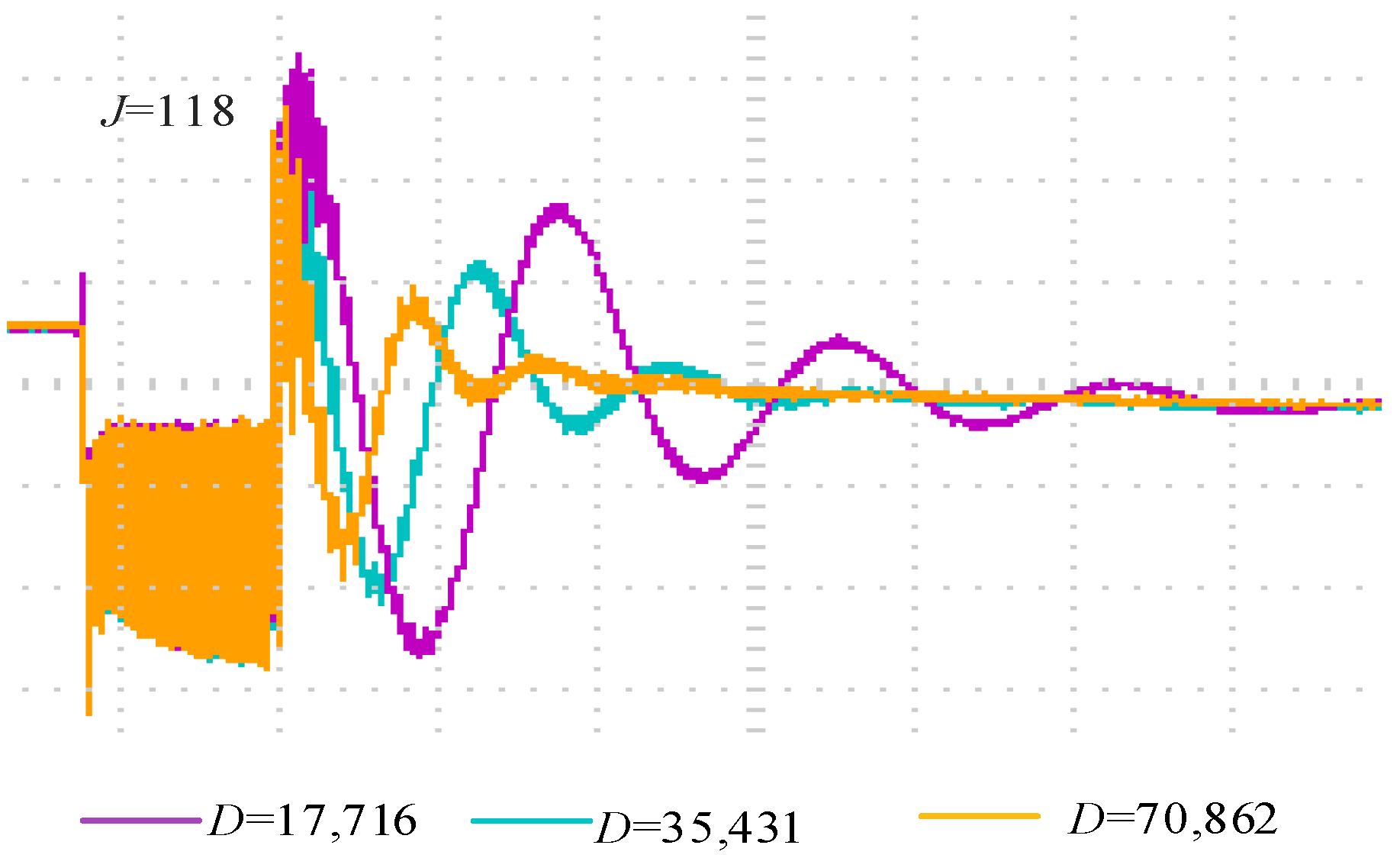
| Parameter | Value |
|---|---|
| Filter inductance (mH) | 14 |
| Grid-connected voltage (kV) | 35 |
| Proportional/integral coefficient of the current controller | 15/300 |
| Proportional/integral coefficient of power controller | 0.4/10 |
| Virtual inertia | 118 |
| Damping coefficient | 35,431 |
| GFM SVG proportional/integral coefficient of power controller | 0.1/1 |
| Parameter | Value |
|---|---|
| Primary side resistance (Ω) | 6.3477 |
| Secondary side resistance (Ω) | 0.17653 |
| Primary side leakage inductance (H) | 0.0008223 |
| Secondary side leakage inductance (H)) | 2.09 × 10−5 |
| Cable length (km) | 5 |
| Cable inductance (mH/km) | 0.297 |
| Cable capacitance (μF/km) | 0.14 |
| Parameter | Value |
|---|---|
| wind speed (m/s) | 6 |
| DFIG number | 10 |
| Rated voltage (V) | 690 |
| Rated power of a single DFIG (MW) | 1.5 |
| Excitation mutual inductance (mH) | 2.6 |
| Stator leakage inductance (mH) | 0.16367 |
| Rotor leakage inductance (mH) | 0.14549 |
| GSC filter inductance (mH) | 0.272 |
| Rotor resistance (mΩ) | 4.6 |
| Stator resistance (mΩ) | 6.6 |
| DC bus capacitor voltage (V) | 1150 |
Disclaimer/Publisher’s Note: The statements, opinions and data contained in all publications are solely those of the individual author(s) and contributor(s) and not of MDPI and/or the editor(s). MDPI and/or the editor(s) disclaim responsibility for any injury to people or property resulting from any ideas, methods, instructions or products referred to in the content. |
© 2024 by the authors. Licensee MDPI, Basel, Switzerland. This article is an open access article distributed under the terms and conditions of the Creative Commons Attribution (CC BY) license (https://creativecommons.org/licenses/by/4.0/).
Share and Cite
Sun, Y.; Wu, H.; Song, X.; Zhang, H.; Zhang, Y.; Chen, J.; Liu, H. Analysis of Influence of Grid-Following and Grid-Forming Static Var Generators on High-Frequency Resonance in Doubly Fed Induction Generator-Based Wind Farms. Electronics 2024, 13, 3879. https://doi.org/10.3390/electronics13193879
Sun Y, Wu H, Song X, Zhang H, Zhang Y, Chen J, Liu H. Analysis of Influence of Grid-Following and Grid-Forming Static Var Generators on High-Frequency Resonance in Doubly Fed Induction Generator-Based Wind Farms. Electronics. 2024; 13(19):3879. https://doi.org/10.3390/electronics13193879
Chicago/Turabian StyleSun, Yong, Hongbin Wu, Xiaozhe Song, Haifeng Zhang, Yifu Zhang, Jikai Chen, and Hongpeng Liu. 2024. "Analysis of Influence of Grid-Following and Grid-Forming Static Var Generators on High-Frequency Resonance in Doubly Fed Induction Generator-Based Wind Farms" Electronics 13, no. 19: 3879. https://doi.org/10.3390/electronics13193879
APA StyleSun, Y., Wu, H., Song, X., Zhang, H., Zhang, Y., Chen, J., & Liu, H. (2024). Analysis of Influence of Grid-Following and Grid-Forming Static Var Generators on High-Frequency Resonance in Doubly Fed Induction Generator-Based Wind Farms. Electronics, 13(19), 3879. https://doi.org/10.3390/electronics13193879





